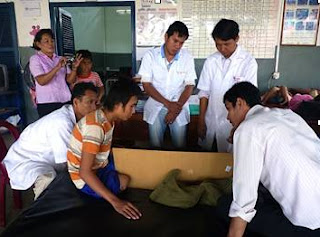This is an account of a recent mirror therapy training trip taken by Moira Judith Mann, Co-Founder of End the Pain Project to Cambodia. The results indicate that mirror therapy to alleviate phantom limb pain for the many amputees in Cambodia will be spread by the 29 physiotherapists who participated in the workshops. ETPP Workshops in other third world countries with large amputee populations can be made possible with your support.
Khuonh Barang, 24, lost his leg above the knee six months ago in a road accident. He suffers phantom limb pain which he feels in the toes and sole of his phantom leg and most of the time he feels heat at the same places.
Physiotherapists at the Veterans International Cambodia Physical Rehabilitation Center in Kratie, Cambodia, prepare Khuong Barang for a Mirror Therapy session. They explain the purpose and instruct to Barang.
Song Sit, PT Clinical Mentor instructs a Technical Coordinator at Kratie Physical Rehabilitation Center with initial assisted Mirror Therapy movements.
Song Sit explains the suggested schedule for Barang for self-administered Mirror Therapy. Barang was given an instruction print-out with his native language to follow each day.
Khuonh Barang reports that after 20 minutes of concentrating on the mirror image of his intact leg, he no longer feels hot in the sole of his phantom foot and that the pain was highly reduced.
The day after the initial Mirror Therapy, Khuonh Barang reported better sleep and seemed in higher spirits than the day before.
A positive response to Mirror Therapy was reported by the diabetic amputee to the clinical staff at Kratie Center.
Ms. Um Naikim, a Prosthetist and Orthotist, uses ETPP Table Top Mirror Tent for practice at Kien Khleang National Rehabilitation Center for the Disabled,.
Mr. Wa Sarun, a bench technician at the Kien Khleang Physical Rehabilitation Center for the Disabled and an amputee, was sceptical about the benefits of Mirror Therapy prior to working with a mirror.
After one session, his experience convinced Mr. Wa that Mirror Therapy was effective in subduing an almost constant pain he has endured since stepping on a land mine.
Mr. Ull Meng Hour, Site Manager of the Prey Veng Physical Rehabiitation Center stepped on a land mine in 1984 and still suffers periodic bouts of phantom limb pain.
Mr. Ull had positive results from his first session of Mirror Therapy. He concentrates on the mirror image of his intact leg using a distortion-free unbreakable plastic donated by the non-profit charity, End The Pain Project.
Prey Veng Physical Rehabilitation Center. clinical staff concentrating on mirror images.
Physiotherapist, Prosthetist and Orthotist at Prey Veng concentrate on mirror images.
Other Physiotherapists at Prey Veng concentrate on mirror images.
Bouth Vorn, 53 years old, stepped on a land mine in Prey Veng Province seven years ago. He received a small grant from VIC to establish his motor and bicycle repair shop. At least two times a week his sleep is disrupted by severe tingling pain in his phantom large toe that spreads to his stump.
Mr. Bouth’s eight-year-old daughter, who might be of some limited assistance when Mr. Bouth, a widower, practices Mirror Therapy at home.
Mr. Bouth experienced some relief the first time practicing Mirror Therapy. Though he did not believe the method would work, at the end of the session he experienced some changes that convinced him to continue practising.





















No comments:
Post a Comment